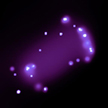The Cartwheel Galaxy is part of a group of galaxies ~five hundred million (500x106) light years away in the direction of the constellation Sculptor. The composite image to the left shows the unique structure of the Cartwheel Galaxy. The image combines data from four different observatories: the Chandra X-ray Observatory (purple); the Galaxy Evolution Explorer satellite (ultraviolet/blue); the Hubble Space Telescope (visible/green); and the Spitzer Space Telescope (infrared/red). The ring-shaped rim of the Cartwheel Galaxy is the result of a rare and spectacular head-on collision between two galaxies. The Cartwheel Galaxy was probably a normal spiral structure galaxy similar to the Milky Way Galaxy before the collision; the spiral structure is beginning to re-emerge, as seen in the faint arms or spokes between the outer ring and the bulls-eye shaped nucleus. The gravitational disruption of a smaller intruder galaxy passing through the Cartwheel Galaxy compressed the interstellar gas and dust - causing a wave of star formation to move out from the impact point like a ripple across the surface of a pond.
The image to the right is a composite showing an optical image of the Cartwheel galaxy and several smaller galaxies associated with the Cartwheel group superimposed with high resolution radio observations of neutral hydrogen (traced by the green contours). The neutral hydrogen trail suggests that the intruder galaxy could be the galaxy located at the lower left of the image.
The Cartwheel Galaxy provides an opportunity to study how extremely massive stars are born in large fragmented gas clouds. The ring structure contains several billion new stars that would not normally have been created in such a short time span. When the most massive of these stars undergo catastrophic collapse as supernova events, neutron stars and black holes are formed. Young supernovas and supernova remnants are ultra and hyperluminous X-ray sources (U/HLXs). Some of the neutron stars and black holes are in contact binary systems with companion stars. Material is pulled from the companion stars and forms accretion discs around the neutron stars and back holes due to their extreme gravitational fields. The in-fall of material from the accretion disc produces highly energetic X-rays, and these systems are also classified as U/HLXs.
Image Analysis of the Cartwheel GalaxyAn activity has been designed for students to examine the Cartwheel Galaxy in both optical and X-ray bands and determine the sources that are producing the ultra and hyperluminous X-ray emissions (U/HLX's). The activity uses ds9 - an image analysis software package. Ds9 allows the user to download a toolbox onto their desktop and remotely access dedicated Linux servers which process the analysis commands.
The ds9 image analysis software allows educators, students, amateur astronomers and the general public to perform X-ray astronomy data analysis using data sets from the Chandra X-ray Observatory, the ds9 image display program, and astrophysical software analysis tools. The program uses the same analysis process that an X-ray astronomer would follow in analyzing the data from a Chandra observation. The download instructions to install the ds9 toolbox on your desktop are located at http://chandra-ed.harvard.edu/install.html . The introduction at http://chandra-ed.harvard.edu/learning_ds9overview.html describes the overview and purpose of the software and gives a short summary of the Chandra mission. The tutorial for using the ds9 software is located at http://chandra-ed.harvard.edu/learning_ds9.html.
NOTE: It is not necessary to read the tutorial before beginning the Star Formation and U/HLXs in the Cartwheel Galaxy activity. All ds9 educational activities are constructed to use one or two specific software tools, and complete constructions to use the tools are given within the individual activities.





